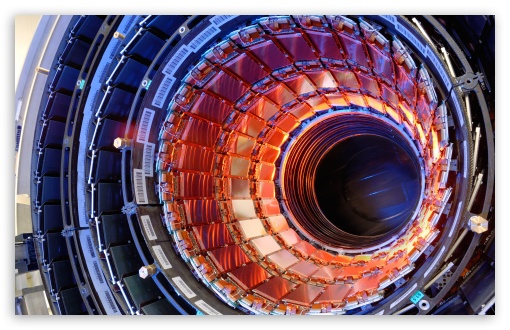Many people know of the Large Hadron Collider (LHC) located near Geneva, Switzerland. However, few understand its true purpose. There are rumors that this collider may allow us to create black holes or unlock the secrets of time travel. The current truth is much more realistic, but just as interesting. This collider is a result of research conducted by CERN, the nuclear research organization for the European Union. CERN employs over 10,000 people from dozens of countries to work on the LHC, essentially a huge particle accelerator. The LHC is an underground ring stretching 17 miles in circumference. It is designed to model the first few moments of the Big Bang. Utilizing thousands of enormous superconducting magnets, each cooled using liquid helium to a temperature colder than space itself, the accelerator can smash protons together at nearly the speed of light (99.9999991% light speed, to be exact). In recent years the collider has brought forth new information regarding the composition of atoms. We learn in school that atoms are the smallest form of matter. However, new information from the LHC reveals that this is not entirely true. There are even smaller things, called quarks, that make up the protons and neutrons found in the nucleus of an atom. The discovery of these quarks has led to much deeper understandings in the field of quantum physics. In addition to quarks, many pairs of anti-quarks appear and disappear at random inside a proton. Additionally, the LHC has led to the discovery of the Higgs Boson, initially only theorized. This is the substance thought to be the fundamental source of mass. The LHC has had the ability to make these discoveries due to the aid of one of the largest computer-grids ever created. This grid has the ability to process the 25 petabytes of information produced by the LHC each year, that's 25,000,000 gigabytes. The new understandings resulting from this huge amount of data may not yet lead to the creation of black holes or time travel, but it is providing us with new ways to view the world around us, and the universe beyond. The study of quarks and Higgs Boson may seem far removed from our daily lives, but could one day lead to inventions that now seem the stuff of science fiction.
http://home.web.cern.ch/topics/large-hadron-collider
http://hyperphysics.phy-astr.gsu.edu/hbase/particles/proton.html
Thursday, April 30, 2015
Thursday, April 23, 2015
Looking Up to the Stars

Our universe has been the subject of study since the dawn of agriculture, once people needed to know when to plant and harvest, they had to memorize the stars during a certain time of year. As a species, we have been craning our head up for centuries, wondering what is out there? Until the middle of the second millennium, all thought relating to the cosmos has been associated with a form of divine power. The invention of the telescope that corresponded to the enlightenment period, a time when educated persons began to question the church and its teachings. These ideas were again reinvented shortly after WW1, when Albert Einstein came up with his ideas of relativity. In short, he presented the idea that what we see and perceive, may not be what is truly there. M. C. Escher portrayed this in his paintings such as this one shown. The direction of the staircase all depends on who is perceiving the staircase in the first place. Nowadays, Physicists widely accept that our universe is made up of about five percent matter and atoms, twenty-five percent dark matter, and seventy percent dark energy. What we are able to perceive and interact with is matter, and while looking through a telescope, one can see thousands and thousands of galaxies each filled with billions of stars and trillions of planets, this is a mere five percent of the universe. Of the other ninety-five percent, dark matter is the least understood- it is a postulated particle which would interact very weakly with normal matter. This dark matter has been researched through careful observation of the speed at which objects orbit the center of a galaxy. This speed is used to calculate the amount of mass the object about which things rotate holds, however, this calculation brings to light a large piece of missing mass (now thought to be dark matter). Dark energy, on the other hand, is much more perceivable. First off, ever since the big bang happened fourteen billion years ago, the universe has been expanding, we know this because of the hue of stellar objects as they move towards and away from us. According to the laws of physics the majority of the people know, this expansion should be slowing down. Upon research of Super Nova explosions to trace this expansion, scientists have discovered that the speed at which the universe is expanding is actually speeding up.
sources:
http://map.gsfc.nasa.gov/universe/uni_matter.html
http://www.arshake.com/en/lenigma-escher/ (painting)
Thursday, April 16, 2015
Coolest Post Around
Temperature, is defined as the energy contained in the movement of atomic particles. Basically, how fast the little atoms that make up every perceivable object in this universe are moving. The colder something is, the less these atoms are moving, hence solid ice when water is frozen. The hotter something gets, the more these atoms move, and we end up with gases, like water vapor. While most people use the Fahrenheit or Celsius measurements to measure heat, scientists use a different scale called kelvin. The intervals of Kelvin are sized the same way as those of celsius except are 273.15 degrees lower because in this scale, 0 is absolute zero. Absolute zero is the theoretical phenomenon that would occur if an object's atoms were cooled to the point where there was absolutely no movement in them. While scientists have never reached it yet, Wolfgang Ketterle, a German physicist, led a team of researchers in 2003 that cooled sodium atoms to 450 picokelvins. Written out that would be .00000000045 kelvin, less than one billionth of 1 degree. This research has led to the discovery of new forms of matter such as Bose-Einstein condensates which form at extremely cold temperatures and have zero viscosity, meaning they are as slippery as physically possible. To show how cold that really is, take space, an empty void filled with nothing but photons blasting off from other stars. Space lies at -451.81 degrees Fahrenheit (-270.45 degrees celsius). In Kelvin, space in 2.7 degrees, meaning that space itself is warmer than the temperatures required to obtain absolute zero.
sources:
http://www.brighthubeducation.com/science-homework-help/111787-importance-of-absolute-zero/
sources:
http://www.brighthubeducation.com/science-homework-help/111787-importance-of-absolute-zero/
Monday, April 6, 2015
Meaningful Dust
In the grand scheme of things, we are nothing but a speck of dust floating on a bigger piece of dust that orbits a larger piece of dust all inside one piece of dust that is larger still. A great example of how insignificant our rock is this picture (bottom), taken by the Hubble space telescope. In this, each speck of light is an entire galaxy. Each galaxy contains millions, billions, of stars. Each star could, and probably does, have multiple planets orbiting them. As a species, we have just now reached the edge of our own cosmic bubble in our solar system. Voyager 1, launched in 1977, reached what we deem "interstellar space" in 2013, traveling at 17,043 meters per second.
Despite being nothing but dust in the cosmic sense, we mustn't think little of our lives here. The cosmos has very little effect on our daily lives. Our lives are everything here on our piece of dust; each of our action, no matter how small, can have a powerful effect. The starfish story is a great example of this. In The Starfish Story, an old man is walking on the beach where thousands of starfish have washed up. He is picking up one at a time and throwing them back to the sea. A younger man tells the older man that his efforts are futile. He will never be able to save even a tenth of the starfish along the beach. He will never make a difference. The old man responds by bending down, picking up a starfish, throwing it out to the sea and saying "I made a difference to that one."
This story demonstrates how an act that seems little to most people, can mean the world to someone else. One small act of kindness by one small speck of dust floating in the vastness of the cosmos can mean everything, can impact life and death. This post can be viewed as morbid and as inspirational. On one hand, we are nothing in relation to the big picture, but in a way this can give us purpose. Life does not last very long, it is one flicker of dust in the cosmos. But for us traveling together on our rock through space, we can make the best of it. We can realize how our actions impact others and try our best to overcome any challenge that faces us.
Despite being nothing but dust in the cosmic sense, we mustn't think little of our lives here. The cosmos has very little effect on our daily lives. Our lives are everything here on our piece of dust; each of our action, no matter how small, can have a powerful effect. The starfish story is a great example of this. In The Starfish Story, an old man is walking on the beach where thousands of starfish have washed up. He is picking up one at a time and throwing them back to the sea. A younger man tells the older man that his efforts are futile. He will never be able to save even a tenth of the starfish along the beach. He will never make a difference. The old man responds by bending down, picking up a starfish, throwing it out to the sea and saying "I made a difference to that one."
This story demonstrates how an act that seems little to most people, can mean the world to someone else. One small act of kindness by one small speck of dust floating in the vastness of the cosmos can mean everything, can impact life and death. This post can be viewed as morbid and as inspirational. On one hand, we are nothing in relation to the big picture, but in a way this can give us purpose. Life does not last very long, it is one flicker of dust in the cosmos. But for us traveling together on our rock through space, we can make the best of it. We can realize how our actions impact others and try our best to overcome any challenge that faces us.
Welcome
In essence, this blog is a philosophy blog, a blog which asks "Why?" and "How?". This blog WILL make you think. Any questions asked will be answered with a combination of philosophy and science, hence the title "SciPhi". Few people realize why humans are so different from other animals, able to adapt to any environment and now ruling on the top of every food chain, it is our ability to reflect on ourselves, on our position in the universe and on Earth, as well as, our effects on everything around us. With our ability to reflect comes the want for discovery, for a cause of events. This, in turn, creates the basis of science, and all questions of science have originated as part of philosophy.
Subscribe to:
Posts (Atom)


